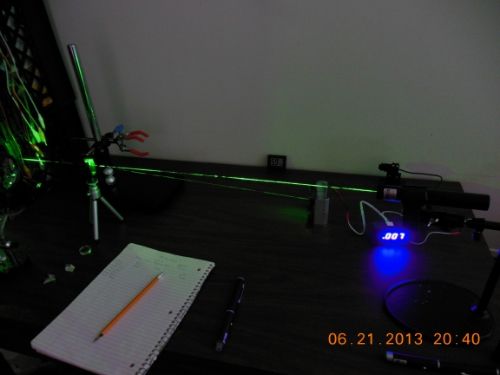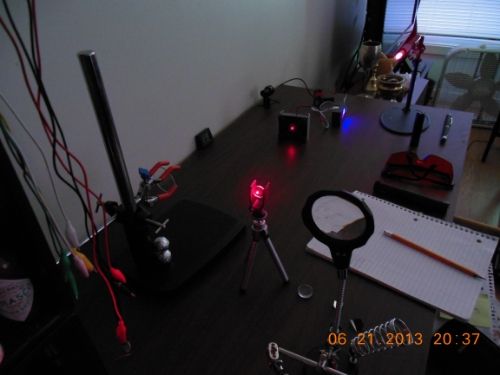Antharak
0
- Joined
- Apr 24, 2013
- Messages
- 549
- Points
- 43
Laser reflections measured with LPM
Note: These readings a deceptively low and should not be used to determine safety factors. The readings are only what my LPM sensor plate was hit by and does not reflect real world conditions. You could easily get hit with over 90% of your lasers power by any reflective surface, (see mirror readings).
Lasers
405nm 86mw Beam divergence 0.201 mRad
532nm 107mw Beam divergence 3.351 mRad
650mn 85mw Beam divergence 3.387 mRad
LPM Blue Fan MKII on low setting (2W max)
Conditions Room Temp 21.8*C RH 63%
Distance to target 24”, Distance from target to LPM 10”-24” (This varies as with some targets the only way to get anything to hit the sensor was to move the LPM closer).
Testing method
Each target was hit in sequence, each shot was spaced by 5 minutes to let the LPM stabilize and to be sure it returned to zero. After running the three lasers, a cool down time of 10 minutes was observed to let them stabilize and reach room temp again. Batteries checked after each shot, including the LPM.
Some of the targets had just too much scatter for a measurement; those are marked as NR, for no reading.
The lens is from a monocular, one side convex and the other flat. The glass plate is from a flashlight as is the plastic plate. The two rods are chrome plated. The plastic magnifier is from a helping hands unit.
405nm
Glass Plate 6mw
Plastic Plate 4mw
Plastic Mag 4mw
Glass Lens CV 2mw
Glass lens Flat 4mw
Alum Foil 1mw
20mm Rod 2mw
8mm Rod NR
Plastic Mirror 65mw
532nm
Glass Plate 7mw
Plastic Plate 6mw
Plastic Mag 2mw
Glass Lens CV 2mw
Glass lens Flat 2mw
Alum Foil 2mw
20mm Rod 2mw
8mm Rod NR
Plastic Mirror 83mw
650nm
Glass Plate 5mw
Plastic Plate 6mw
Plastic Mag 2mw
Glass Lens CV 1mw
Glass lens Flat NR
Alum Foil 5mw
20mm Rod 3mw
8mm Rod 2mw
Plastic Mirror 73mw
Some pics of the setup
532nm with glass plate

650nm with glass plate

Note: These readings a deceptively low and should not be used to determine safety factors. The readings are only what my LPM sensor plate was hit by and does not reflect real world conditions. You could easily get hit with over 90% of your lasers power by any reflective surface, (see mirror readings).
Lasers
405nm 86mw Beam divergence 0.201 mRad
532nm 107mw Beam divergence 3.351 mRad
650mn 85mw Beam divergence 3.387 mRad
LPM Blue Fan MKII on low setting (2W max)
Conditions Room Temp 21.8*C RH 63%
Distance to target 24”, Distance from target to LPM 10”-24” (This varies as with some targets the only way to get anything to hit the sensor was to move the LPM closer).
Testing method
Each target was hit in sequence, each shot was spaced by 5 minutes to let the LPM stabilize and to be sure it returned to zero. After running the three lasers, a cool down time of 10 minutes was observed to let them stabilize and reach room temp again. Batteries checked after each shot, including the LPM.
Some of the targets had just too much scatter for a measurement; those are marked as NR, for no reading.
The lens is from a monocular, one side convex and the other flat. The glass plate is from a flashlight as is the plastic plate. The two rods are chrome plated. The plastic magnifier is from a helping hands unit.
405nm
Glass Plate 6mw
Plastic Plate 4mw
Plastic Mag 4mw
Glass Lens CV 2mw
Glass lens Flat 4mw
Alum Foil 1mw
20mm Rod 2mw
8mm Rod NR
Plastic Mirror 65mw
532nm
Glass Plate 7mw
Plastic Plate 6mw
Plastic Mag 2mw
Glass Lens CV 2mw
Glass lens Flat 2mw
Alum Foil 2mw
20mm Rod 2mw
8mm Rod NR
Plastic Mirror 83mw
650nm
Glass Plate 5mw
Plastic Plate 6mw
Plastic Mag 2mw
Glass Lens CV 1mw
Glass lens Flat NR
Alum Foil 5mw
20mm Rod 3mw
8mm Rod 2mw
Plastic Mirror 73mw
Some pics of the setup
532nm with glass plate

650nm with glass plate




